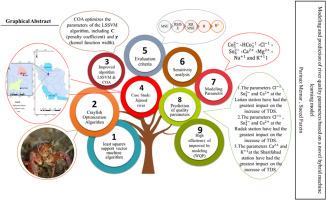基于新型混合机器学习模型的河流水质参数建模与预测
IF 4.1
3区 地球科学
Q2 GEOSCIENCES, MULTIDISCIPLINARY
引用次数: 0
摘要
河流中的水污染是一个主要问题,使用机器学习技术对水质进行建模是一种有效的方法。总溶解固体是一个关键的水质指标,因为不适当的水平会影响工业,农业和城市用水。最小二乘支持向量机(LSSVM)算法在建模和预测水质参数方面具有很高的准确性,特别是与小龙虾优化算法(COA)相结合可以提高预测精度。利用Jajrood流域(Latiyan、Rodak和Sharifabad站)的数据,应用LSSVM和LSSVM- coa对CO3−2、HCO3−1、Cl−1、So4−2、Ca+2、Mg+2、Na+1和K+1等关键水质参数进行了建模和预测。结果的准确性各不相同,但LSSVM-COA算法更准确,特别是在Sharifabad站,测试期间组合参数的R值为0.92,RRMSE为0.40。预测分析表明,Cl−1、So4−2和Ca+2等参数对TDS的提高影响最为显著,特别是当每个参数的值提高50%时。本文章由计算机程序翻译,如有差异,请以英文原文为准。

Modeling and prediction of river quality parameters based on a novel hybrid machine learning model
Water pollution in rivers is a major issue, and modeling water quality using machine learning techniques is an effective approach. Total dissolved solids is a key water quality indicator, as improper levels can affect industrial, agricultural, and urban water use. Least Squares Support Vector Machine (LSSVM) algorithms are highly accurate for modeling and predicting water quality parameters, especially when combined with the Crayfish Optimization Algorithm (COA) to enhance prediction accuracy. A study using data from the Jajrood basin (Latiyan, Rodak, and Sharifabad stations) applied LSSVM and LSSVM-COA to model and predict key water quality parameters, including CO3−2, HCO3−1, Cl−1, So4−2, Ca+2, Mg+2, Na+1 and K+1. The accuracy of the results varied, but the LSSVM-COA algorithm was more accurate, particularly at Sharifabad station, where the R values for the combined parameters during testing were 0.92 and the RRMSE was 0.40. Predictive analysis indicated that parameters like Cl−1, So4−2 and Ca+2 had the most significant impact on increasing TDS, especially when each parameter's value was increased by 50 %.
求助全文
通过发布文献求助,成功后即可免费获取论文全文。
去求助
来源期刊

Physics and Chemistry of the Earth
地学-地球科学综合
CiteScore
5.40
自引率
2.70%
发文量
176
审稿时长
31.6 weeks
期刊介绍:
Physics and Chemistry of the Earth is an international interdisciplinary journal for the rapid publication of collections of refereed communications in separate thematic issues, either stemming from scientific meetings, or, especially compiled for the occasion. There is no restriction on the length of articles published in the journal. Physics and Chemistry of the Earth incorporates the separate Parts A, B and C which existed until the end of 2001.
Please note: the Editors are unable to consider submissions that are not invited or linked to a thematic issue. Please do not submit unsolicited papers.
The journal covers the following subject areas:
-Solid Earth and Geodesy:
(geology, geochemistry, tectonophysics, seismology, volcanology, palaeomagnetism and rock magnetism, electromagnetism and potential fields, marine and environmental geosciences as well as geodesy).
-Hydrology, Oceans and Atmosphere:
(hydrology and water resources research, engineering and management, oceanography and oceanic chemistry, shelf, sea, lake and river sciences, meteorology and atmospheric sciences incl. chemistry as well as climatology and glaciology).
-Solar-Terrestrial and Planetary Science:
(solar, heliospheric and solar-planetary sciences, geology, geophysics and atmospheric sciences of planets, satellites and small bodies as well as cosmochemistry and exobiology).
 求助内容:
求助内容: 应助结果提醒方式:
应助结果提醒方式:


